Bénouville and Pegasus Bridge
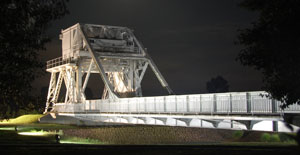
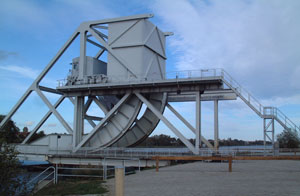
Pegasus Bridge
The task of capturing the bridges over both the Orne River and Canal fell to a selected force drawn from the 2d Battalion, Oxfordshire and Buckinghamshire Light Infantry, and the Royal Engineers, commanded by Major John Howard. The six gliders carrying this force were to land in the dark on the approaches to the bridges. In what was one of the great navigational feats of D-Day morning, three of the gliders crash-landed (the most explicit term describing a glider's reunion with the earth) within forty seven yards of the east end of the canal bridge. A lone German sentry who might have sounded the alarm did not do so because he assumed that an airplane had crashed nearby. His mistake was costly. While one of Howard's squads crossed the bridge in a rush, taking a single casualty, Lt. Den Brotheridge, the first British officer KIA. Others overran nearby pillboxes and trenches before the surprised Germans could reach their positions. Within 20 minutes, the bridge and its defences were in British hands.
The river Orne Bridge
The assault on the Orne River bridge went as smoothly, although one of the three gliders assigned to that operation missed the bridge area altogether, landing miles away in the flooded Dives valley. Only one of the remaining two gliders landed near the bridge. The twenty-odd men from that lone glider rushed the bridge despite the loss of surprise. Fortunately, the German guards did not know the odds; they scattered before the determined British charge.
Not only had the bridges been captured easily, but they were intact. Both structures had been wired for demolition, but the explosive charges had not been planted. Major Howard's men held their prizes throughout D-Day while German pressure mounted. Around 1200 hours, some two and a half minutes after they were to have been reinforced, the beleaguered defenders were startled by the distant sound of bagpipes. The 6 Commando of the 1st Special Service Brigade, led by Brigadier Lord Lovat, had arrived with piper Bill Millin. The two forces joined ranks to the tune of «Blue Bonnets over the Border» and the crack of small-arms fire. Although both bridges would not be truly secure until units of the 3d British Division arrived late in the afternoon, the skirl of Millin's pipes had assured the men of Howard's command that the seaborne invasion was ashore.
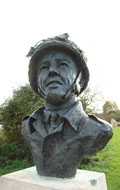

Lt. Den Brotheridge, British Airborne Forces, was killed by a friendly shot on D-Day, capturing Pegasus Bridge. He lies in the civil cemetery of Ranville church. Note the tribute from the owners of Cafe Gondree the first home in France to be liberated on D-Day.
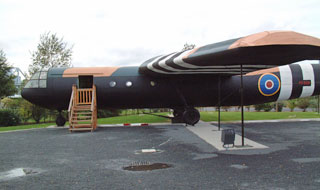
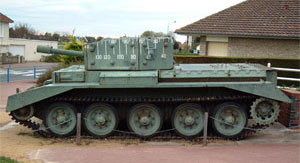
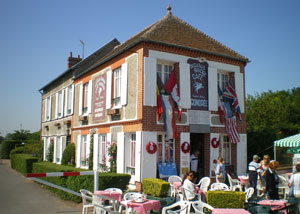
The Centaur tank facing Café Gondrée (Bénouville)
A Centaur version of the British Cruiser Mark VIII tank mounting a 95-mm gun. This tank belonged to the 5th Independent Battery, Royal Marine Armoured Support Regiment, which landed at La Brèche d'Hermanville. Three such regiments were organized a few months before D-Day to provide additional fire support to the first waves of infantry. This Centaur IV was recovered in 1975.
A British Commonwealth cemetery at Ranville is a mile and half from the Pegasus Bridge. 2,563 British Commonwealth soldiers are buried there, including Lieutenant Den Brotheridge, who was killed in the attack on the bridge. The round-about in front of the cemetery is named the Place General Sir Richard Gale, after the commander of the 6th British Airborne Division. A plaque directly opposite the cemetery commemorates the events of D Day in Ranville.
Three memorials in Amfreville commemorating the 4 and 6 commandos and the 1st Special Service Brigade of which they were a part.
A plaque marking a stop on the Pegasus Trail Battlefield Tour. These markers follow the route of the 6th Airborne Division.
Nearby Pegasus Bridge
Pegasus Bridge as a site is especially rich in D-Day memorabilia. In addition to the original bridge itself (complete with painted-over bullet marks and a mortar impact in the bridge counterweight), the following monuments, memorials, and artefacts are found nearby:
- A stone cross at the Bénouville crossroads commemorating the 7th Light Infantry Battalion of the Parachute Regiment. The Café Gondrée with its plaque proudly claiming it to be the first house liberated in France.
- The Musée des Troupes Aéroportées. Open daily during July and August 0900-1900; closed mid-October to mid-March. Hours during the remainder of the year vary. Admission charge.
- A marker commemorating the linkup between the Ox and Bucks and the 6 Commando. At the 40th anniversary ceremony in 1984, Bill Millin was photographed next to this marker. Three orientation tables marks the spots where the Horsa gliders came to rest. They are located on the southeast side of the bridge, below the canal bank.
- German pillbox complete with the 50-mm anti-tank gun used by Howard's men to silence a sniper in Bénouville.